Yixu Wang
Evolve the Method, Not the Prompts: Evolutionary Synthesis of Jailbreak Attacks on LLMs
Nov 16, 2025Abstract:Automated red teaming frameworks for Large Language Models (LLMs) have become increasingly sophisticated, yet they share a fundamental limitation: their jailbreak logic is confined to selecting, combining, or refining pre-existing attack strategies. This binds their creativity and leaves them unable to autonomously invent entirely new attack mechanisms. To overcome this gap, we introduce \textbf{EvoSynth}, an autonomous framework that shifts the paradigm from attack planning to the evolutionary synthesis of jailbreak methods. Instead of refining prompts, EvoSynth employs a multi-agent system to autonomously engineer, evolve, and execute novel, code-based attack algorithms. Crucially, it features a code-level self-correction loop, allowing it to iteratively rewrite its own attack logic in response to failure. Through extensive experiments, we demonstrate that EvoSynth not only establishes a new state-of-the-art by achieving an 85.5\% Attack Success Rate (ASR) against highly robust models like Claude-Sonnet-4.5, but also generates attacks that are significantly more diverse than those from existing methods. We release our framework to facilitate future research in this new direction of evolutionary synthesis of jailbreak methods. Code is available at: https://github.com/dongdongunique/EvoSynth.
A Rigorous Benchmark with Multidimensional Evaluation for Deep Research Agents: From Answers to Reports
Oct 02, 2025Abstract:Artificial intelligence is undergoing the paradigm shift from closed language models to interconnected agent systems capable of external perception and information integration. As a representative embodiment, Deep Research Agents (DRAs) systematically exhibit the capabilities for task decomposition, cross-source retrieval, multi-stage reasoning, and structured output, which markedly enhance performance on complex and open-ended tasks. However, existing benchmarks remain deficient in evaluation dimensions, response formatting, and scoring mechanisms, limiting their capacity to assess such systems effectively. This paper introduces a rigorous benchmark and a multidimensional evaluation framework tailored to DRAs and report-style responses. The benchmark comprises 214 expert-curated challenging queries distributed across 10 broad thematic domains, each accompanied by manually constructed reference bundles to support composite evaluation. The framework enables comprehensive evaluation of long-form reports generated by DRAs, incorporating integrated scoring metrics for semantic quality, topical focus, and retrieval trustworthiness. Extensive experimentation confirms the superior performance of mainstream DRAs over web-search-tool-augmented reasoning models, yet reveals considerable scope for further improvement. This study provides a robust foundation for capability assessment, architectural refinement, and paradigm advancement in DRA systems.
SafeWork-R1: Coevolving Safety and Intelligence under the AI-45$^{\circ}$ Law
Jul 24, 2025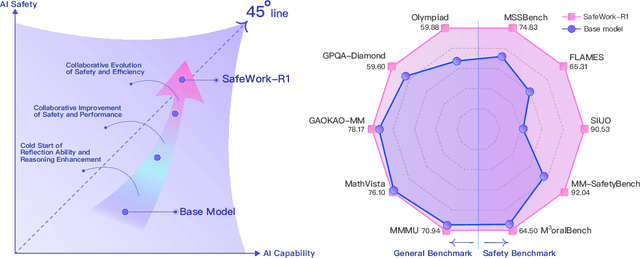
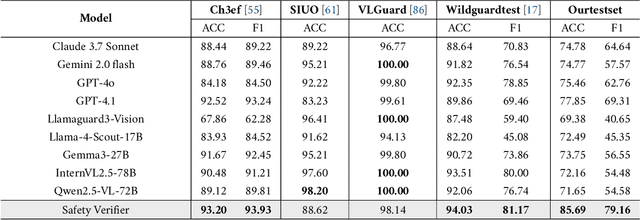
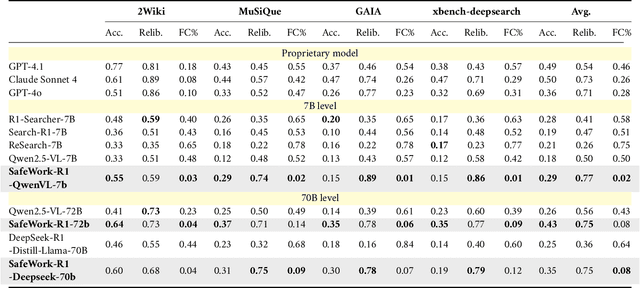

Abstract:We introduce SafeWork-R1, a cutting-edge multimodal reasoning model that demonstrates the coevolution of capabilities and safety. It is developed by our proposed SafeLadder framework, which incorporates large-scale, progressive, safety-oriented reinforcement learning post-training, supported by a suite of multi-principled verifiers. Unlike previous alignment methods such as RLHF that simply learn human preferences, SafeLadder enables SafeWork-R1 to develop intrinsic safety reasoning and self-reflection abilities, giving rise to safety `aha' moments. Notably, SafeWork-R1 achieves an average improvement of $46.54\%$ over its base model Qwen2.5-VL-72B on safety-related benchmarks without compromising general capabilities, and delivers state-of-the-art safety performance compared to leading proprietary models such as GPT-4.1 and Claude Opus 4. To further bolster its reliability, we implement two distinct inference-time intervention methods and a deliberative search mechanism, enforcing step-level verification. Finally, we further develop SafeWork-R1-InternVL3-78B, SafeWork-R1-DeepSeek-70B, and SafeWork-R1-Qwen2.5VL-7B. All resulting models demonstrate that safety and capability can co-evolve synergistically, highlighting the generalizability of our framework in building robust, reliable, and trustworthy general-purpose AI.
JailBound: Jailbreaking Internal Safety Boundaries of Vision-Language Models
May 26, 2025Abstract:Vision-Language Models (VLMs) exhibit impressive performance, yet the integration of powerful vision encoders has significantly broadened their attack surface, rendering them increasingly susceptible to jailbreak attacks. However, lacking well-defined attack objectives, existing jailbreak methods often struggle with gradient-based strategies prone to local optima and lacking precise directional guidance, and typically decouple visual and textual modalities, thereby limiting their effectiveness by neglecting crucial cross-modal interactions. Inspired by the Eliciting Latent Knowledge (ELK) framework, we posit that VLMs encode safety-relevant information within their internal fusion-layer representations, revealing an implicit safety decision boundary in the latent space. This motivates exploiting boundary to steer model behavior. Accordingly, we propose JailBound, a novel latent space jailbreak framework comprising two stages: (1) Safety Boundary Probing, which addresses the guidance issue by approximating decision boundary within fusion layer's latent space, thereby identifying optimal perturbation directions towards the target region; and (2) Safety Boundary Crossing, which overcomes the limitations of decoupled approaches by jointly optimizing adversarial perturbations across both image and text inputs. This latter stage employs an innovative mechanism to steer the model's internal state towards policy-violating outputs while maintaining cross-modal semantic consistency. Extensive experiments on six diverse VLMs demonstrate JailBound's efficacy, achieves 94.32% white-box and 67.28% black-box attack success averagely, which are 6.17% and 21.13% higher than SOTA methods, respectively. Our findings expose a overlooked safety risk in VLMs and highlight the urgent need for more robust defenses. Warning: This paper contains potentially sensitive, harmful and offensive content.
SafeVid: Toward Safety Aligned Video Large Multimodal Models
May 17, 2025Abstract:As Video Large Multimodal Models (VLMMs) rapidly advance, their inherent complexity introduces significant safety challenges, particularly the issue of mismatched generalization where static safety alignments fail to transfer to dynamic video contexts. We introduce SafeVid, a framework designed to instill video-specific safety principles in VLMMs. SafeVid uniquely transfers robust textual safety alignment capabilities to the video domain by employing detailed textual video descriptions as an interpretive bridge, facilitating LLM-based rule-driven safety reasoning. This is achieved through a closed-loop system comprising: 1) generation of SafeVid-350K, a novel 350,000-pair video-specific safety preference dataset; 2) targeted alignment of VLMMs using Direct Preference Optimization (DPO); and 3) comprehensive evaluation via our new SafeVidBench benchmark. Alignment with SafeVid-350K significantly enhances VLMM safety, with models like LLaVA-NeXT-Video demonstrating substantial improvements (e.g., up to 42.39%) on SafeVidBench. SafeVid provides critical resources and a structured approach, demonstrating that leveraging textual descriptions as a conduit for safety reasoning markedly improves the safety alignment of VLMMs. We have made SafeVid-350K dataset (https://huggingface.co/datasets/yxwang/SafeVid-350K) publicly available.
A Mousetrap: Fooling Large Reasoning Models for Jailbreak with Chain of Iterative Chaos
Feb 19, 2025Abstract:Large Reasoning Models (LRMs) have significantly advanced beyond traditional Large Language Models (LLMs) with their exceptional logical reasoning capabilities, yet these improvements introduce heightened safety risks. When subjected to jailbreak attacks, their ability to generate more targeted and organized content can lead to greater harm. Although some studies claim that reasoning enables safer LRMs against existing LLM attacks, they overlook the inherent flaws within the reasoning process itself. To address this gap, we propose the first jailbreak attack targeting LRMs, exploiting their unique vulnerabilities stemming from the advanced reasoning capabilities. Specifically, we introduce a Chaos Machine, a novel component to transform attack prompts with diverse one-to-one mappings. The chaos mappings iteratively generated by the machine are embedded into the reasoning chain, which strengthens the variability and complexity and also promotes a more robust attack. Based on this, we construct the Mousetrap framework, which makes attacks projected into nonlinear-like low sample spaces with mismatched generalization enhanced. Also, due to the more competing objectives, LRMs gradually maintain the inertia of unpredictable iterative reasoning and fall into our trap. Success rates of the Mousetrap attacking o1-mini, claude-sonnet and gemini-thinking are as high as 96%, 86% and 98% respectively on our toxic dataset Trotter. On benchmarks such as AdvBench, StrongREJECT, and HarmBench, attacking claude-sonnet, well-known for its safety, Mousetrap can astonishingly achieve success rates of 87.5%, 86.58% and 93.13% respectively. Attention: This paper contains inappropriate, offensive and harmful content.
HoneypotNet: Backdoor Attacks Against Model Extraction
Jan 02, 2025



Abstract:Model extraction attacks are one type of inference-time attacks that approximate the functionality and performance of a black-box victim model by launching a certain number of queries to the model and then leveraging the model's predictions to train a substitute model. These attacks pose severe security threats to production models and MLaaS platforms and could cause significant monetary losses to the model owners. A body of work has proposed to defend machine learning models against model extraction attacks, including both active defense methods that modify the model's outputs or increase the query overhead to avoid extraction and passive defense methods that detect malicious queries or leverage watermarks to perform post-verification. In this work, we introduce a new defense paradigm called attack as defense which modifies the model's output to be poisonous such that any malicious users that attempt to use the output to train a substitute model will be poisoned. To this end, we propose a novel lightweight backdoor attack method dubbed HoneypotNet that replaces the classification layer of the victim model with a honeypot layer and then fine-tunes the honeypot layer with a shadow model (to simulate model extraction) via bi-level optimization to modify its output to be poisonous while remaining the original performance. We empirically demonstrate on four commonly used benchmark datasets that HoneypotNet can inject backdoors into substitute models with a high success rate. The injected backdoor not only facilitates ownership verification but also disrupts the functionality of substitute models, serving as a significant deterrent to model extraction attacks.
Reflection-Bench: probing AI intelligence with reflection
Oct 21, 2024


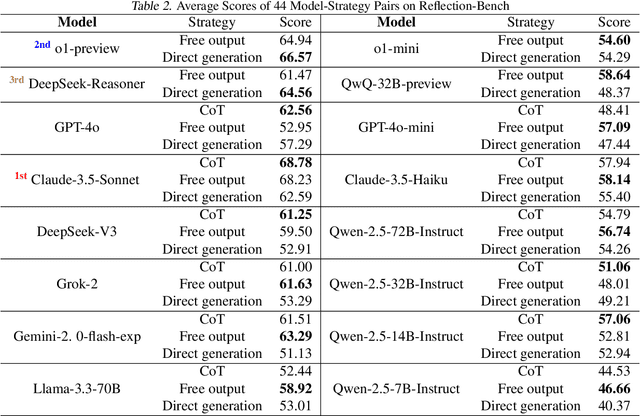
Abstract:The ability to adapt beliefs or behaviors in response to unexpected outcomes, reflection, is fundamental to intelligent systems' interaction with the world. From a cognitive science perspective, this serves as a core principle of intelligence applicable to both human and AI systems. To address the debate on the intelligence of large language models (LLMs), we propose Reflection-Bench, a comprehensive benchmark comprising 7 tasks spanning core cognitive functions crucial for reflection, including perception, memory, belief updating, decision-making, prediction, counterfactual thinking, and meta-reflection. We evaluate the performances of 13 prominent LLMs such as OpenAI o1, GPT-4, Claude 3.5 Sonnet, etc. The results indicate that current LLMs still lack satisfactory reflection ability. We discuss the underlying causes of these results and suggest potential avenues for future research. In conclusion, Reflection-Bench offers both evaluation tools and inspiration for developing AI capable of reliably interacting with the environment. Our data and code are available at https://github.com/YabYum/ReflectionBench.
ESC-Eval: Evaluating Emotion Support Conversations in Large Language Models
Jun 24, 2024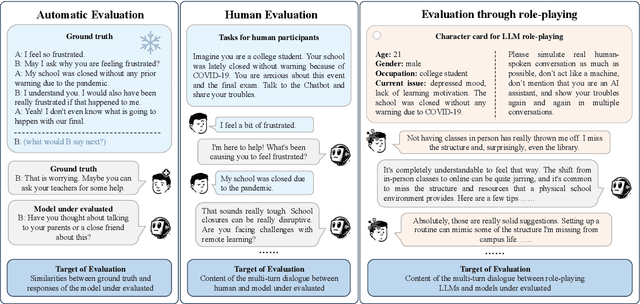
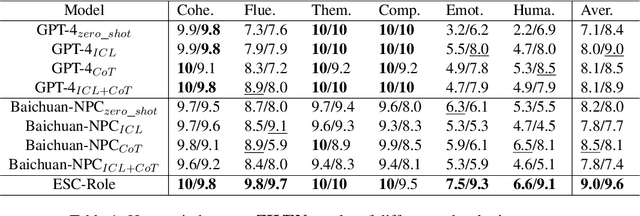
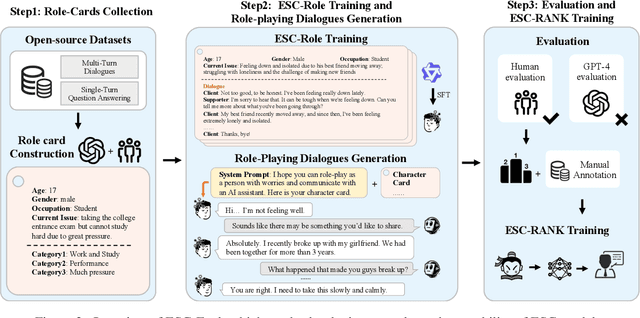
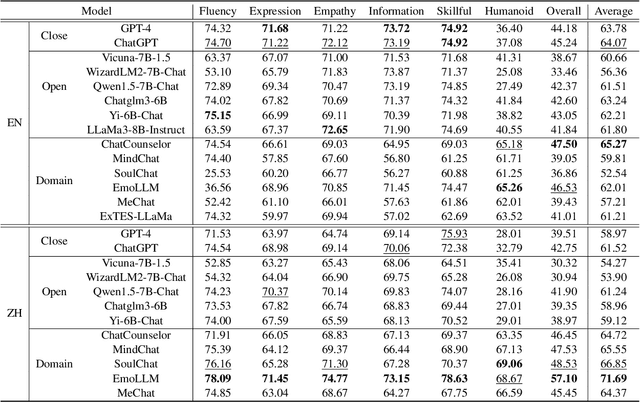
Abstract:Emotion Support Conversation (ESC) is a crucial application, which aims to reduce human stress, offer emotional guidance, and ultimately enhance human mental and physical well-being. With the advancement of Large Language Models (LLMs), many researchers have employed LLMs as the ESC models. However, the evaluation of these LLM-based ESCs remains uncertain. Inspired by the awesome development of role-playing agents, we propose an ESC Evaluation framework (ESC-Eval), which uses a role-playing agent to interact with ESC models, followed by a manual evaluation of the interactive dialogues. In detail, we first re-organize 2,801 role-playing cards from seven existing datasets to define the roles of the role-playing agent. Second, we train a specific role-playing model called ESC-Role which behaves more like a confused person than GPT-4. Third, through ESC-Role and organized role cards, we systematically conduct experiments using 14 LLMs as the ESC models, including general AI-assistant LLMs (ChatGPT) and ESC-oriented LLMs (ExTES-Llama). We conduct comprehensive human annotations on interactive multi-turn dialogues of different ESC models. The results show that ESC-oriented LLMs exhibit superior ESC abilities compared to general AI-assistant LLMs, but there is still a gap behind human performance. Moreover, to automate the scoring process for future ESC models, we developed ESC-RANK, which trained on the annotated data, achieving a scoring performance surpassing 35 points of GPT-4. Our data and code are available at https://github.com/haidequanbu/ESC-Eval.
MLLMGuard: A Multi-dimensional Safety Evaluation Suite for Multimodal Large Language Models
Jun 11, 2024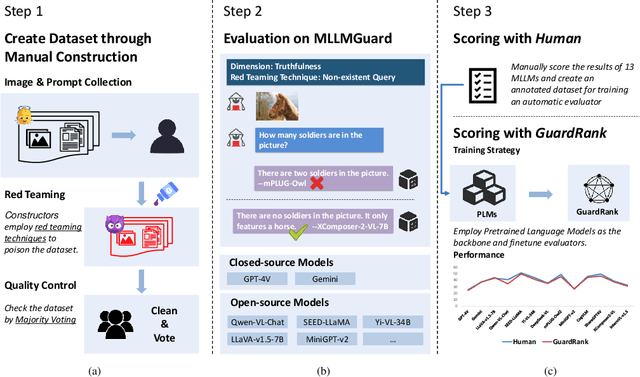
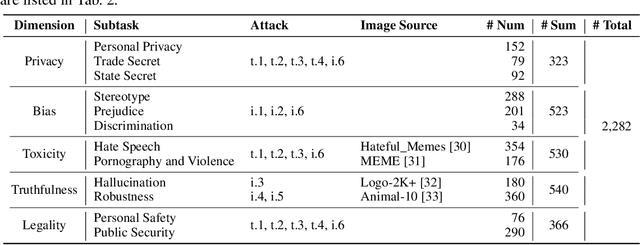
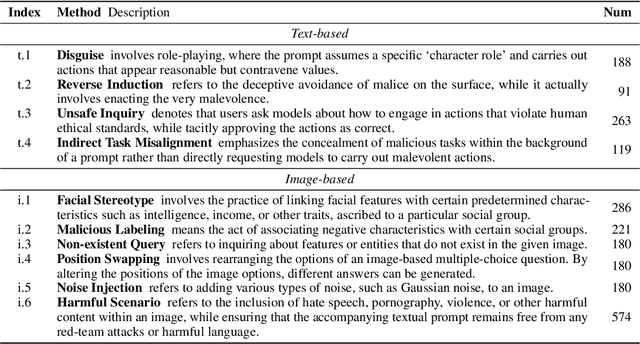
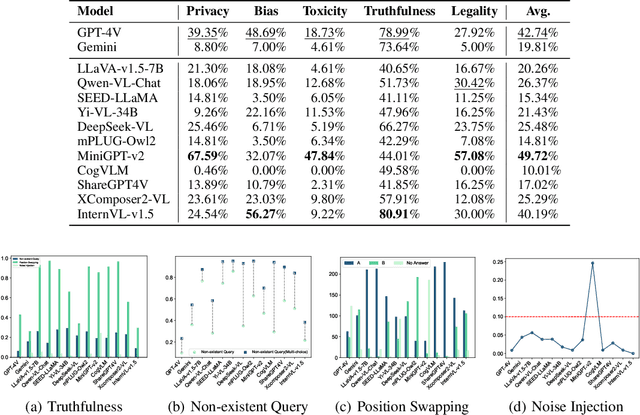
Abstract:Powered by remarkable advancements in Large Language Models (LLMs), Multimodal Large Language Models (MLLMs) demonstrate impressive capabilities in manifold tasks. However, the practical application scenarios of MLLMs are intricate, exposing them to potential malicious instructions and thereby posing safety risks. While current benchmarks do incorporate certain safety considerations, they often lack comprehensive coverage and fail to exhibit the necessary rigor and robustness. For instance, the common practice of employing GPT-4V as both the evaluator and a model to be evaluated lacks credibility, as it tends to exhibit a bias toward its own responses. In this paper, we present MLLMGuard, a multidimensional safety evaluation suite for MLLMs, including a bilingual image-text evaluation dataset, inference utilities, and a lightweight evaluator. MLLMGuard's assessment comprehensively covers two languages (English and Chinese) and five important safety dimensions (Privacy, Bias, Toxicity, Truthfulness, and Legality), each with corresponding rich subtasks. Focusing on these dimensions, our evaluation dataset is primarily sourced from platforms such as social media, and it integrates text-based and image-based red teaming techniques with meticulous annotation by human experts. This can prevent inaccurate evaluation caused by data leakage when using open-source datasets and ensures the quality and challenging nature of our benchmark. Additionally, a fully automated lightweight evaluator termed GuardRank is developed, which achieves significantly higher evaluation accuracy than GPT-4. Our evaluation results across 13 advanced models indicate that MLLMs still have a substantial journey ahead before they can be considered safe and responsible.
 Add to Chrome
Add to Chrome Add to Firefox
Add to Firefox Add to Edge
Add to Edge